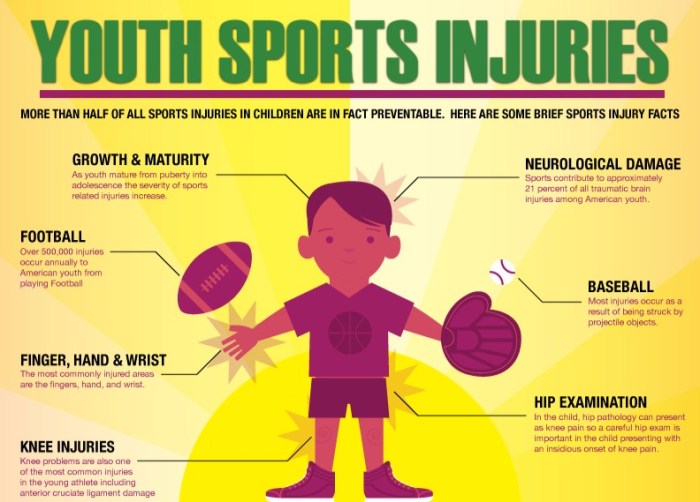Kicking off with sports injury prevention, this opening paragraph is designed to captivate and engage the readers, setting the tone american high school hip style that unfolds with each word. Sports injury prevention is essential for athletes looking to stay on top of their game and avoid setbacks that could sideline their performance. From common injuries to prevention strategies, this topic delves into the crucial aspects of keeping athletes healthy and in peak condition.
Importance of Sports Injury Prevention

In the world of sports, injury prevention is not just a recommendation but a necessity for athletes striving to achieve peak performance and longevity in their careers. By taking proactive measures to prevent sports injuries, athletes can maintain their physical health, enhance their overall performance, and extend their playing careers.
Sports injuries can have a significant impact on an athlete’s performance and career trajectory. Not only can injuries sideline athletes and prevent them from competing, but they can also lead to long-term health issues that may affect their ability to continue participating in their sport. Injuries can also hinder an athlete’s progress, disrupt training schedules, and result in missed opportunities for competition and growth.
Proper sports injury prevention measures can help athletes avoid common injuries that may occur during training or competition. Some examples of preventable sports injuries include sprains, strains, fractures, dislocations, and overuse injuries such as tendonitis. By implementing strategies such as proper warm-ups, stretching exercises, strength training, and using appropriate protective gear, athletes can reduce their risk of experiencing these types of injuries and stay in top condition to perform at their best.
Common Types of Sports Injuries

Sports injuries can range from minor sprains to serious fractures, impacting athletes of all levels. Understanding the different types of injuries and their causes is crucial for implementing effective prevention strategies.
Sprains, Sports injury prevention
Sprains occur when ligaments are stretched beyond their limits, leading to tears. This type of injury is common in sports that involve sudden changes in direction or impact, such as basketball or soccer. Ankle sprains, in particular, are prevalent among athletes.
Strains
Muscle strains result from overstretching or tearing of muscle fibers. They often occur during activities that require explosive movements or excessive force, like sprinting or weightlifting. Hamstring strains are a frequent occurrence in sports due to the demands on this muscle group.
Fractures
Fractures are breaks in the bone that can range from hairline cracks to complete breaks. High-impact sports like football or rugby are more prone to fractures due to collisions or falls. Stress fractures, caused by repetitive stress on the bone, are common in running and jumping sports.
Understanding the Mechanism of Injury
It is essential to understand how different types of sports injuries occur to develop effective prevention strategies. By analyzing the specific movements, forces, and conditions that lead to sprains, strains, and fractures, coaches and athletes can implement targeted training programs and techniques to reduce the risk of injury.
Strategies for Preventing Sports Injuries
When it comes to preventing sports injuries, there are several key strategies that athletes can implement to minimize their risk of getting hurt. These strategies include incorporating pre-game warm-up routines, ensuring proper equipment fitting, and prioritizing rest and recovery.
Pre-Game Warm-Up Routines
Before engaging in any physical activity, athletes should always perform a thorough warm-up routine to prepare their muscles and joints for the demands of the sport. A proper warm-up increases blood flow to the muscles, improves flexibility, and reduces the risk of strains and sprains. Dynamic stretches, light cardio exercises, and sport-specific drills are all essential components of an effective warm-up routine.
Proper Equipment Fitting
Wearing the right equipment that fits properly is crucial in preventing sports injuries. Ill-fitting gear can lead to discomfort, restricted movement, and even serious injuries. Athletes should ensure that their helmets, pads, shoes, and other protective gear are the right size and provide adequate support and protection for their specific sport. Regularly checking and replacing worn-out equipment is also important for injury prevention.
Rest and Recovery
Rest and recovery are equally important aspects of injury prevention as training and competition. Overuse injuries, such as stress fractures, tendonitis, and muscle strains, can occur when athletes do not allow their bodies enough time to rest and repair between workouts or games. Adequate sleep, proper nutrition, and active recovery techniques like stretching and foam rolling are essential for promoting muscle recovery and reducing the risk of overuse injuries.
Role of Strength and Conditioning in Injury Prevention
Strength training plays a crucial role in preventing sports injuries by improving muscle strength, flexibility, and endurance. Conditioning exercises complement strength training by enhancing overall physical fitness and reducing the risk of injury.
Benefits of Strength Training for Injury Prevention
- Increases muscle strength and stability around joints, reducing the risk of sprains and strains.
- Improves flexibility, allowing for better range of motion and reducing the likelihood of muscle imbalances.
- Enhances overall body mechanics and posture, which can prevent overuse injuries.
Benefits of Conditioning Exercises for Injury Prevention
- Improves cardiovascular endurance, which is essential for sustaining performance and preventing fatigue-related injuries.
- Enhances agility, speed, and coordination, reducing the risk of falls or collisions during sports activities.
- Increases muscular endurance, promoting better muscle function and reducing the risk of muscle fatigue injuries.
Specific Strength and Conditioning Exercises for Injury-Prone Areas
- Core Strengthening: Planks, Russian twists, and leg raises help stabilize the spine and prevent lower back injuries.
- Shoulder Stability: External rotations, shoulder presses, and scapular retractions strengthen the shoulder muscles to prevent rotator cuff injuries.
- Knee Support: Squats, lunges, and leg extensions target the quadriceps and hamstrings to reduce the risk of knee injuries.
- Ankle Strength: Calf raises, ankle circles, and balance exercises improve ankle stability and prevent sprains.